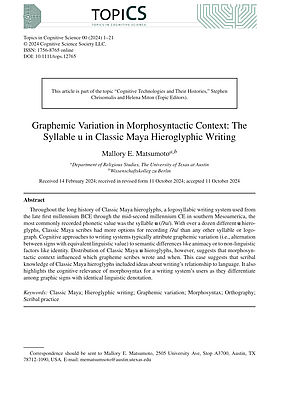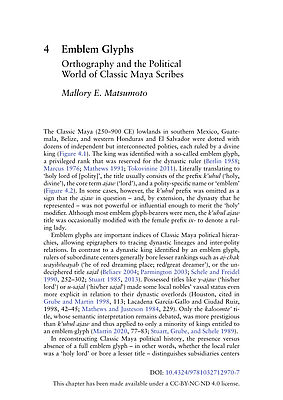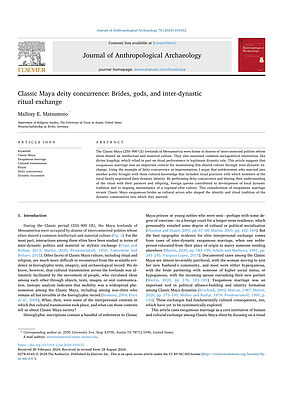
Mallory Matsumoto, PhD
Assistant Professor of Religious Studies
University of Texas at Austin
Born in 1988 in Washington, D.C.
Studied Anthropology at Brown University
Project
Scripting Ritual: Classic Maya Religion and the Spread of Hieroglyphic Writing
This project offers a novel analysis of the relationship between religion, politics, and writing in ancient Mesoamerica, one of just four world regions where writing was invented independently. It examines the intersection of scribal and religious transmission among Classic Maya elites (250–900 CE), whose participation in joint rituals and the exchange of religious artifacts promoted cultural cohesion across a politically fragmented landscape.In the region spanning parts of what are now Mexico, Guatemala, Belize, Honduras, and El Salvador, scholars have defined Classic Maya civilization according to a series of common cultural traits, including a hieroglyphic script. Rapid progress in hieroglyphic decipherment since the 1980s has fed a surge in studies of Classic Maya culture, economy, and politics that provide an ever-richer image of these dynamically interconnected, interdependent polities. All evidence indicates that Classic Maya society hosted a vibrant intellectual culture that included ritual practices, political ideologies, mathematical and astronomical study, artistic canons, and hieroglyphic literacy. Still, it remains unclear how these archaeologically ephemeral phenomena spread or how intellectual exchange intersected with politics, trade, or military encounters.
The project centers on two key questions: what role did religion play in the development of Maya hieroglyphic writing? And how did the Classic Maya maintain a coherent, mutually legible script in the absence of political unification? To explore these questions, the project uses epigraphic and iconographic analysis to reconstruct trajectories of hieroglyphic and religious transmission and to contextualize them within interactions across Classic Maya society more broadly. It also addresses the consequences of this Classic Maya case for understanding religious exchange as a social process that can foster, rather than just mirror, cultural and political integration.
Recommended Reading
Matsumoto, Mallory E. (2022). “Letters of Conversion: Meta-alphabetic Discourse and Linguistic Participation in Colonial Highland Guatemala.” Journal of Linguistic Anthropology 32 (1): 28–51. https://doi.org/10.1111/jola.12309.
—. (2022). “Qualia of Proximity and Materiality in Classic Maya Hieroglyphs.” Signs and Society 10 (1): 48–77. https://doi.org/10.1086/717562.
—. (2023). “Cultures of Creativity: Hieroglyphic Innovation in the Classic Maya Lowlands.” Cambridge Archaeological Journal 33 (1): 99–118. https://doi.org/10.1017/S0959774322000208.
Colloquium, 16.01.2024
Exogamy among the Classic Maya: Women, Politics, and Ritual Exchange
Publications from the Fellows' Library
Matsumoto, Mallory (Oxford [u.a.], 2024)
Graphemic variation in morphysyntactic context : the Syllable u in classic Maya hieroglyphic writing
Matsumoto, Mallory (Orlando, Fla, 2024)
Classic Maya deity condurrence : brides, gods, and inter-dynastic ritual exchange
Matsumoto, Mallory (New York, 2024)
Emblem glyphs : orthography and the political world of classic Maya scibes
Matsumoto, Mallory (Cambridge, 2023)
"In the name of the (God)Father" : baptismal naming in early colonial Guatemala
Matsumoto, Mallory (Cambridge, 2023)
Cultures of creativity : hieroglyphic innovation in the classic Maya lowlands
Matsumoto, Mallory (Cambridge, 2023)
Sculptural traditionalism and innovation in the classic Maya kingdom of Sak Tz'i', Mexico
Matsumoto, Mallory (Dordrecht [u.a.], 2022)
Archaeology and epigraphy in the digital era
Matsumoto, Mallory (Malden, Mass., 2022)
Matsumoto, Mallory (Chicago, Ill. [u.a.], 2022)
Qualia of proximity and materiality in classic Maya hieroglyphs
Matsumoto, Mallory (Chicago, Ill., 2019)
Copying in clay : Maya hieroglyphs and changing modes of scribal practice



